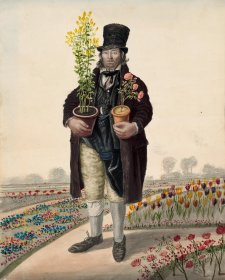Sea bathing was originally a therapeutic rather than a recreational activity and, from early in the 18th century, we find the patrons of the mineral springs at Scarborough taking to the broader waters of the North Sea. The Duchess of Manchester was one of those who led the fashion, with a dip in August 1732. The medical benefits of sea bathing being further promoted by Dr Richard Russell’s A dissertation concerning the use of sea water in diseases of the glands, by the 1750s ocean baths had become something of a craze amongst the gentry. Like Scarborough, nearby Bridlington was blessed by having both a spa and a beach of fine, hard sand and, while not as popular nor as well-serviced as Scarborough, it was nevertheless seen as a place where:
Peers, Knights, and Squires, and dames repair
To bathe, and drink, and take the air
Towards the end of the 18th century, the fashion for bathing received a further boost from royal example. George iii took his family on holiday to Weymouth in the 1790s and, in 1798, sent his youngest daughter Princess Amelia to bathe at Worthing to cure her lame knee. The Prince of Wales (the future George IV) was particularly keen: from 1783 his regular seaside summers saw the fishing village of Brighthelmstone transformed into the resort town of Brighton, ‘London-by-the-Sea’. George even sent his hunting dogs to Brighton for the cure. He also owned John Russell’s portrait of Martha Gunn, the most celebrated of Brighton’s bathing attendants, and the fine mezzotint of this pastel by William Nutter (1797) was dedicated to His Royal Highness.
Mrs Gunn may have been the model Regency ‘dipper’, but there were plenty of others. Thomas Rowlandson illustrates one (or a punning composite of all) in The widow Ducker and her nymphs, and John Dempsey’s bathing woman was apparently well-known, at least to the tourists at Bridlington.
Dempsey’s bather is an impressive figure. Solidly built, she would certainly have needed the adipose tissue to help her withstand the cold waters of the North Sea, and the muscular strength to support her clients against the beating waves. She stands confidently, arms akimbo, in front of her domain: a roughly drawn landscape of Bridlington Bay and the North Sands, with Flamborough Head and its lighthouse visible in the distance. At the water’s edge is her ‘boutique’, a bathing machine.
While men in this period would most often swim naked, entering the water from the beach or from dinghies, women were required to be more modest, at the cost of a shilling plus a tip. They began the procedure by entering a bathing machine, essentially a wooden hut on wheels. Those at Bridlington Quay were evidently identified by name: there was the Lord Wellington, the General Blücher, the Queen Elizabeth and so on — it is just possible to decipher ‘King’ painted on the side of the box in this picture. A horse would tow the bathing machine a short way into the water, where the dipper would help the lady to undress and don a long bathing costume. Dempsey’s dipper carries such a ‘baptismal gown’ under her right arm. When changed, the client would be assisted into the water, where her attendant(s) would help her to get thoroughly wet. The procedure is illustrated in an engraving in George Walker’s Costume of Yorkshire, which is not only set in the same landscape, but also shows dippers dressed similarly to Dempsey’s model: in a blue overdress, with a hat worn over a headscarf.
Dempsey’s bathing woman is not identified by name. A photograph (c. 1860) exists in the archives of East Riding, Yorkshire, however, of a Mrs Bullock and a Mrs Welbourne, then after-hours caretakers of the Bridlington bathing machines. This sounds like an appropriate job for a retired dipper and, indeed, a close comparison of Mrs Welbourne with Dempsey’s picture is most suggestive: the stoutness, the firm (but possibly humorous) set of the mouth, the scarf, the taste for a hat with a downturned brim are common to both women. Perhaps Dempsey’s bathing woman is Mrs Welbourne, 30 years previously, in her commanding physical prime.
Collection: Tasmanian Museum and Art Gallery, presented by C. Docker, 1956



Dempsey’s people: a folio of British street portraits 1824–1844 is the first exhibition to showcase the compelling watercolour images of English street people made by the itinerant English painter John Dempsey throughout the first half of the nineteenth century.



Visit us, learn with us, support us or work with us! Here’s a range of information about planning your visit, our history and more!



We depend on your support to keep creating our programs, exhibitions, publications and building the amazing portrait collection!